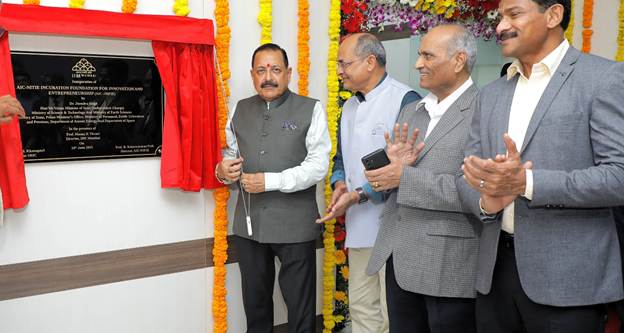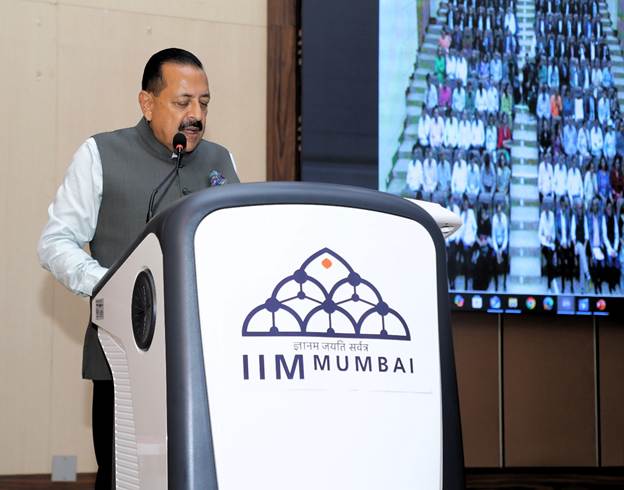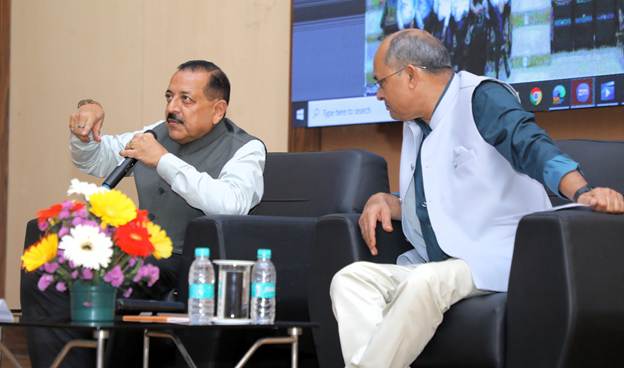Union Minister Dr. Jitendra Singh Calls for Closer Collaboration Between Institutes of Higher Education—Such as IITs, IIMs, AIIMS, IIMC, CSIR—and Scientific Institutions to Build Sustainable Startups
Union Minister Dr. Jitendra Singh Calls for Closer Collaboration Between Institutes of Higher Education—Such as IITs, IIMs, AIIMS, IIMC, CSIR—and Scientific Institutions to Build Sustainable Startups
After inaugurating a state-of-the-art Incubation Centre at IIM Mumbai, Union Minister of State (Independent Charge) for Science & Technology, Dr. Jitendra Singh, made a clarion call for greater collaboration among institutions of higher education and scientific research, such as IITs, IIMs, AIIMS, IIMC, and CSIR, to nurture sustainable startups and innovation-driven entrepreneurship.
While interacting with students, Dr. Singh emphasized that “The age of working in silos is over.” He asserted that the integration of academia, industry, and government is essential for India to meet its rapid development goals. “Greater synergy between the public and private sectors is not an option—it’s a necessity,” he remarked.

Dr. Jitendra Singh, Union Minister of State (Independent Charge) for Science & Technology, Earth Sciences, and MoS in the Prime Minister Office, Dept. of Space and Atomic Energy highlighted the democratization of civil services and the growing wave of women-led development over the past decade. Citing the Aditya L1 space mission, he proudly shared that it was led by women scientists, reflecting the inclusive and aspirational rise of India.
He recounted a powerful story of a 16-year-old girl from a militancy-affected town who cracked the IIT entrance exam without coaching, using just a smartphone and determination—“12 hours a day for 8 months, powered by the internet,” she told him. “This is the new India, where dreams transcend limitations,” said the Minister.
Dr. Singh also drew a contrast between the last 11 years and the preceding decade, noting that earlier generations had limited career choices. “Today’s youth have a wide array of professional avenues, supported by a rise in national self-esteem, which is reflected in how Indian students abroad command respect and better offers,” he said. He also noted that in recent years, girls have consistently topped the Civil Services Examination, signaling a significant shift in the country’s social landscape.

Charting India’s rise in research and development, Dr. Singh said, “India’s Gross Expenditure on R&D (GERD) has doubled in the last decade—from ₹60,196 crore in 2013-14 to ₹1,27,381 crore today—under Prime Minister Modi’s leadership.”
He underscored that the future of India’s economy will be shaped by homegrown advancements in biotechnology, artificial intelligence, and quantum computing. Key to this has been government support, like the launch of India’s first indigenous DNA-based COVID vaccine, under the Department of Biotechnology (DBT).
He also hailed the BioE3 Policy—Biotechnology for Economy, Environment, and Employment—as a game-changer, propelling India to the forefront of global biotech.
With India rising to the 3rd largest startup ecosystem in the world, Dr. Singh revealed that the number of startups has grown from 350 in 2014 to over 1.5 lakh in 2025. “Startups in space tech are adding significant value,” he said, noting that the government has allowed 100% FDI in the space sector and set up a ₹1,000 crore venture fund for space-based startups.

Dr. Singh debunked the myth that startups are limited to IT professionals from elite institutions. “Startups are built on aptitude, ideas, and innovation—not just fancy degrees,” he stated. He reiterated that entrepreneurial potential exists across every sector, from biotech to agri-tech.
Dr. Singh shared the success of the Aroma Mission, where more than 3,000 lavender-based startups are generating substantial income in rural India, creating employment and transforming lives.
He also emphasized that the National Education Policy (NEP-2020) is a strong enabler of the startup ecosystem, offering students flexibility in subject selection and a holistic learning environment to become innovators, not just job seekers.
Dr. Singh pointed out that agriculture, though contributing only 14–15% to GDP, supports the largest section of India’s population. He stressed the hidden potential in this sector and the importance of leveraging technology and innovation to unlock it. Dr. Singh also called the present youth “fortunate and uniquely positioned” as they will be at the prime of their careers in 2047, when India celebrates 100 years of Independence.
“You are the generation that will lead a Viksit Bharat—a fully developed India. This is not just your opportunity, it is your responsibility,” he stated, urging students to prepare themselves for the historic role they are destined to play in shaping the nation’s future.